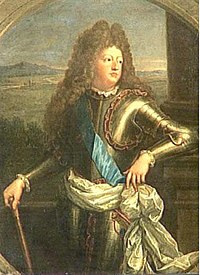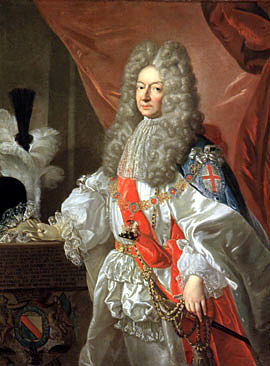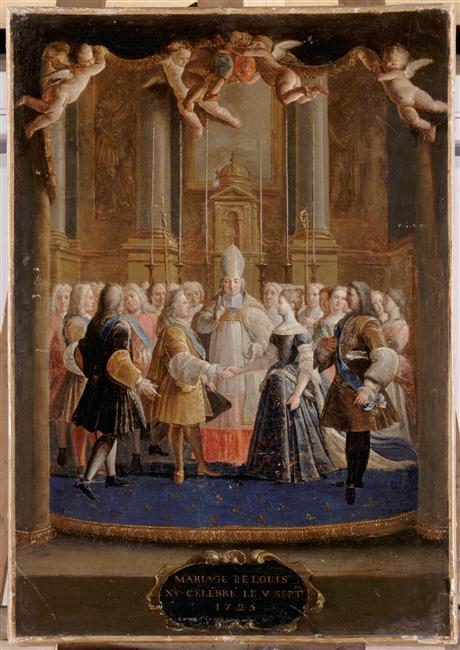As an addition to my other post on New Year's festivities at Versailles I have gathered some examples of the sort of presents that were exchanged within the gilded walls of Versailles. These include presents given in all sorts of occasions.
Gifts of cold hard cash was common too but I find that these represents the splendour of the court of France. Also, posts and positions were frequently given away, especially at weddings.
Presents
When the Duchesse de Bourgogne gave birth to the future Louis XV she received an oriental casket from Louis XIV. It opened via a secretly hidden spring and once the Duchesse found it she discovered a perfect set of pearls and 4.000 louis d'or.
Louis-Philippe received two horses from the royal stables when he first met Louis XV at the age of fourteen
Marie Antoinette sent a chemise à la Reine to her friend, the Duchess of Devonshire. Once the Duchess had been seen sporting the new trend it immediately became all the rage.
Wedding Presents
Marie Thérèse sent Louis XIV a beautiful chest filled with chocolate - a treat that had not yet established itself at the French court.
Louis XIV gave jewellery worth 73.000 livres to Mademoiselle d'Orlèans when she married the Duc de Berri. The groom was given jewels worth a staggering 300.000 livres!
When the King's brother, Monsieur, married Louis XIV bestowed on him the vast palace of the Palais-Royal. It would remain in the hands of the Orlèans family.
Madame de Montespan arranged the marriage of one of her sons to the eldest daughter of the Duc d'Uzès, Julie-Françoise. She then proceeded to give the bride a necklace of diamonds and emeralds worth 40.000 écus and a basket filled with scents, ribbons, fans and gloves.
Marie Antoinette received the diamonds and pearls that had belonged to the previous Dauphine as well as a single-row pearl choker brought to France by Anne of Austria. A fan encrusted with diamonds was also a part of the King's wedding gifts; so was bracelets with her cipher written on the blue enamel clasps. As a gesture of good faith Madame Adélaïde gave the new Dauphine a key that would allow her to use the private corridors.
It was common - especially during Louis XV's reign - to give the ladies attending a wedding (such as maid-of-honour) fans as presents.
New Year's Presents
When Madame de Montespan's career as the King's maitresse-en-titre was coming to an end Athénaïs decided to grant her (soon-to-be) former lover a present in her typical splendid style. Athénaïs paid 4000 pistoles to have a book illustrating the sieges of the campaign in Holland in 1672 created. Not only was the book bound with gold it contained verses by Racine and Boileau. Louis XIV was thrilled with his present.
The first son of Marie Antoinette and Louis XVI was gifted with a set of dominos made from the same stone and marble used for the Bastille.
Marie Lescszynska received a golden snuff-box from the King; however, what the Queen did not know was that the box had originally been intended for the King's new mistress, Madame de Pompadour's mother.
Diplomatic Presents
Louis XIV received the speciality wine of Transylvania called Tokaji from Francis II Rákóczi. That actually resulted in wine becoming rather popular with the French court.
In 1668 Louis XIV received an elephant from the King of Portugal. The elephant had originally come from Congo and died in 1681.
In 1686 the King of Siam sent a substantial amount of gifts to the entire royal family. These gifts were as exotic as one would expect from the King of Siam since they all related to the relatively new trend of drinking hot chocolate. The King received two silver chocolate pitchers; similarly the Dauphin was also given two pitchers but these were decorated with elaborate floral motifs in gold. The Queen received a smaller but golden pitcher.
Two porcelain vases, a centrepiece and two smaller ewers were sent from Saxony to France as a part of the plan to have the Dauphin married to Marie Josepha of Saxony. In that same period another set was made for the Duc de Richelieu who had been sent to Saxony for the proxy wedding in January 1747.
In 1758 Louis XV sent the first diplomatic set of Sèvres-porcelain to King Frederik V of Denmark. It consisted of 72 plates and 164 hollow ware pieces; the cost was 34.542 livres. The set was in response to a stallion of the Frederiksborg breed sent by the Danish King earlier.
 |
Plate from the set sent to
Frederik V |
Madame de Pompadour played an essential role in getting Louis XV closer to a reconciliation with Austria and for that Empress Maria Theresia (Marie Antoinette's mother) sent the royal favourite two lacquer boxes from the Empress' own collection. The boxes were personally selected and sent from Vienna. The gift truly was magnificent since the mounts were not of ormolu as was usually the case but of solid gold and a portrait of the Empress was incorporated into the design.
Louis XVI received two large eagles for the royal menagerie from the Governor of Kamchatka
Estate Presents
Louis XIV gave Madame de Montespan the estate of Clagny in response to the golden book mentioned earlier in 1682
In 1769 Louis XV gave the château de Louveciennes to Madame du Barry
A month after ascending to the throne in 1774 Louis XVI handed over the keys for the Petit Trianon to Marie Antoinette.
Madame Élisabeth received the estate of Montreuil - where she had spent a great part of her childhood - as a present from her brother.











































